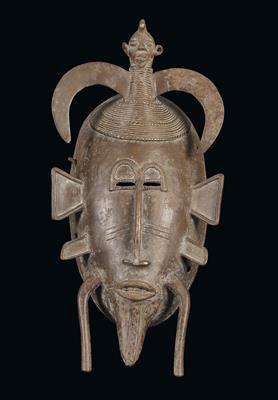Senufo, Ivory Coast, Mali, Burkina Faso: a rare Kpelié mask made from metal.

The ‘Kpelié mask’, also known as the ‘Kodal mask’ is the most well-known mask type of the Senufo people. A similar mask made from wood exists (more common, see cat. no. 40). The present mask, made from metal, is rarer. Previously they were reserved only for blacksmiths, who produced them themselves.
The present metal mask is made of yellow cast-alloy (brass) and cast with a ‘waste mould’. It displays all the characteristic features of the ‘Kpelié’ mask type. Generally, these masks represent a ‘beautiful girl’ with a pointed, oval face, crowned with two ‘horns’. A small head, with a typical Senufo female hairstyle, rests in between the horns. The eyebrows and slit eyes are delicately joined and sit above a long, slender nose. The small, open mouth reveals two rows of teeth. The peg in the lower lip of many women, which features very often, is here suggested by a waved line, encased by two straight lines that head vertically towards the pointed chin. Adding to the typical appearance of a ‘Kpelié mask’ are the carved scarification marks that appear on the temples, cheeks and at the corners of the mouth and also the classic projections on both sides: in line with the eyes, on the cheeks and the ‘legs’ to the right and left of the mouth below. It remains unclear as to whether these ‘legs’ are parts of the most important sacrificial animals (chicken and sheep). In any case the masked dancer uses these ‘legs’ to hold the mask in position throughout their wild leaps. The blacksmiths of neighbouring Dioula cast similar masks to the ‘Kpelié’ of the Senufo people. The present piece however, with all its classic details, originates without doubt from the Senufo culture. An object with slight corrosion in places due to age and a light brown, old patina. No damage. Height: 33 cm; first third of the 20th century. (ME)
Provenance:
French collection; Austrian private collection.
Lit.:
'Die Kunst der Senufo' by H.-J. Koloß & Till Förster, catalogue of the Museum für Völkerkunde Berlin, ill. 48, 49; 'Erde und Erz' by K.-F. Schädler, ill. 149.
Specialist: Erwin Melchardt
 Erwin Melchardt
Erwin Melchardt
+43-1-515 60-465
erwin.melchardt@dorotheum.at
09.06.2016 - 17:00
- Realized price: **
-
EUR 1,250.-
- Starting bid:
-
EUR 900.-
Senufo, Ivory Coast, Mali, Burkina Faso: a rare Kpelié mask made from metal.
The ‘Kpelié mask’, also known as the ‘Kodal mask’ is the most well-known mask type of the Senufo people. A similar mask made from wood exists (more common, see cat. no. 40). The present mask, made from metal, is rarer. Previously they were reserved only for blacksmiths, who produced them themselves.
The present metal mask is made of yellow cast-alloy (brass) and cast with a ‘waste mould’. It displays all the characteristic features of the ‘Kpelié’ mask type. Generally, these masks represent a ‘beautiful girl’ with a pointed, oval face, crowned with two ‘horns’. A small head, with a typical Senufo female hairstyle, rests in between the horns. The eyebrows and slit eyes are delicately joined and sit above a long, slender nose. The small, open mouth reveals two rows of teeth. The peg in the lower lip of many women, which features very often, is here suggested by a waved line, encased by two straight lines that head vertically towards the pointed chin. Adding to the typical appearance of a ‘Kpelié mask’ are the carved scarification marks that appear on the temples, cheeks and at the corners of the mouth and also the classic projections on both sides: in line with the eyes, on the cheeks and the ‘legs’ to the right and left of the mouth below. It remains unclear as to whether these ‘legs’ are parts of the most important sacrificial animals (chicken and sheep). In any case the masked dancer uses these ‘legs’ to hold the mask in position throughout their wild leaps. The blacksmiths of neighbouring Dioula cast similar masks to the ‘Kpelié’ of the Senufo people. The present piece however, with all its classic details, originates without doubt from the Senufo culture. An object with slight corrosion in places due to age and a light brown, old patina. No damage. Height: 33 cm; first third of the 20th century. (ME)
Provenance:
French collection; Austrian private collection.
Lit.:
'Die Kunst der Senufo' by H.-J. Koloß & Till Förster, catalogue of the Museum für Völkerkunde Berlin, ill. 48, 49; 'Erde und Erz' by K.-F. Schädler, ill. 149.
Specialist: Erwin Melchardt
 Erwin Melchardt
Erwin Melchardt
+43-1-515 60-465
erwin.melchardt@dorotheum.at
|
Buyers hotline
Mon.-Fri.: 10.00am - 5.00pm
kundendienst@dorotheum.at +43 1 515 60 200 |
| Auction: | Tribal Art - Africa |
| Auction type: | Saleroom auction |
| Date: | 09.06.2016 - 17:00 |
| Location: | Vienna | Palais Dorotheum |
| Exhibition: | 04.06. - 09.06.2016 |
** Purchase price incl. buyer's premium and VAT
It is not possible to turn in online buying orders anymore. The auction is in preparation or has been executed already.
